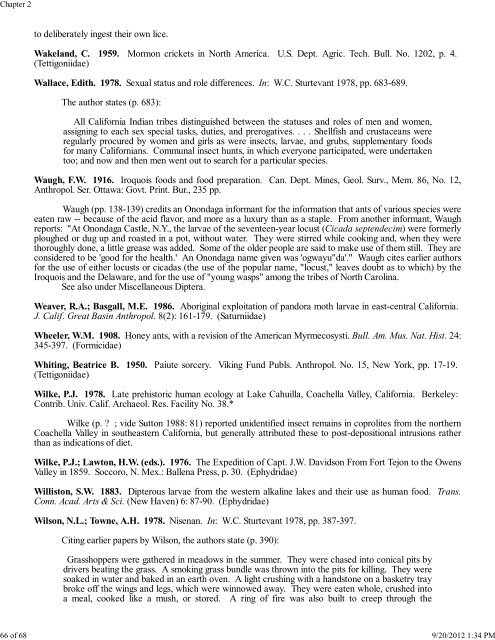Chapter 2. Insect Foods of North American Indigenous Populations ...
Chapter 2. Insect Foods of North American Indigenous Populations ...
Chapter 2. Insect Foods of North American Indigenous Populations ...
Create successful ePaper yourself
Turn your PDF publications into a flip-book with our unique Google optimized e-Paper software.
<strong>Chapter</strong> 266 <strong>of</strong> 68 9/20/2012 1:34 PMto deliberately ingest their own lice.Wakeland, C. 1959. Mormon crickets in <strong>North</strong> America. U.S. Dept. Agric. Tech. Bull. No. 1202, p. 4.(Tettigoniidae)Wallace, Edith. 1978. Sexual status and role differences. In: W.C. Sturtevant 1978, pp. 683-689.The author states (p. 683):All California Indian tribes distinguished between the statuses and roles <strong>of</strong> men and women,assigning to each sex special tasks, duties, and prerogatives. . . . Shellfish and crustaceans wereregularly procured by women and girls as were insects, larvae, and grubs, supplementary foodsfor many Californians. Communal insect hunts, in which everyone participated, were undertakentoo; and now and then men went out to search for a particular species.Waugh, F.W. 1916. Iroquois foods and food preparation. Can. Dept. Mines, Geol. Surv., Mem. 86, No. 12,Anthropol. Ser. Ottawa: Govt. Print. Bur., 235 pp.Waugh (pp. 138-139) credits an Onondaga informant for the information that ants <strong>of</strong> various species wereeaten raw -- because <strong>of</strong> the acid flavor, and more as a luxury than as a staple. From another informant, Waughreports: "At Onondaga Castle, N.Y., the larvae <strong>of</strong> the seventeen-year locust (Cicada septendecim) were formerlyploughed or dug up and roasted in a pot, without water. They were stirred while cooking and, when they werethoroughly done, a little grease was added. Some <strong>of</strong> the older people are said to make use <strong>of</strong> them still. They areconsidered to be 'good for the health.' An Onondaga name given was 'ogwayu"da'." Waugh cites earlier authorsfor the use <strong>of</strong> either locusts or cicadas (the use <strong>of</strong> the popular name, "locust," leaves doubt as to which) by theIroquois and the Delaware, and for the use <strong>of</strong> "young wasps" among the tribes <strong>of</strong> <strong>North</strong> Carolina.See also under Miscellaneous Diptera.Weaver, R.A.; Basgall, M.E. 1986. Aboriginal exploitation <strong>of</strong> pandora moth larvae in east-central California.J. Calif. Great Basin Anthropol. 8(2): 161-179. (Saturniidae)Wheeler, W.M. 1908. Honey ants, with a revision <strong>of</strong> the <strong>American</strong> Myrmecosysti. Bull. Am. Mus. Nat. Hist. 24:345-397. (Formicidae)Whiting, Beatrice B. 1950. Paiute sorcery. Viking Fund Publs. Anthropol. No. 15, New York, pp. 17-19.(Tettigoniidae)Wilke, P.J. 1978. Late prehistoric human ecology at Lake Cahuilla, Coachella Valley, California. Berkeley:Contrib. Univ. Calif. Archaeol. Res. Facility No. 38.*Wilke (p. ? ; vide Sutton 1988: 81) reported unidentified insect remains in coprolites from the northernCoachella Valley in southeastern California, but generally attributed these to post-depositional intrusions ratherthan as indications <strong>of</strong> diet.Wilke, P.J.; Lawton, H.W. (eds.). 1976. The Expedition <strong>of</strong> Capt. J.W. Davidson From Fort Tejon to the OwensValley in 1859. Soccoro, N. Mex.: Ballena Press, p. 30. (Ephydridae)Williston, S.W. 1883. Dipterous larvae from the western alkaline lakes and their use as human food. Trans.Conn. Acad. Arts & Sci. (New Haven) 6: 87-90. (Ephydridae)Wilson, N.L.; Towne, A.H. 1978. Nisenan. In: W.C. Sturtevant 1978, pp. 387-397.Citing earlier papers by Wilson, the authors state (p. 390):Grasshoppers were gathered in meadows in the summer. They were chased into conical pits bydrivers beating the grass. A smoking grass bundle was thrown into the pits for killing. They weresoaked in water and baked in an earth oven. A light crushing with a handstone on a basketry traybroke <strong>of</strong>f the wings and legs, which were winnowed away. They were eaten whole, crushed intoa meal, cooked like a mush, or stored. A ring <strong>of</strong> fire was also built to creep through the
















